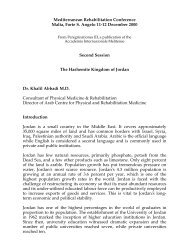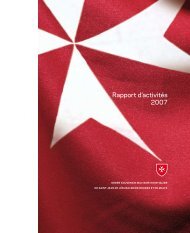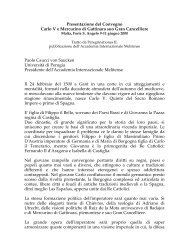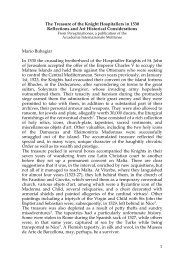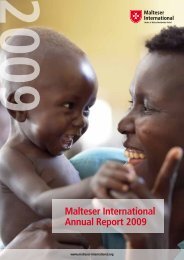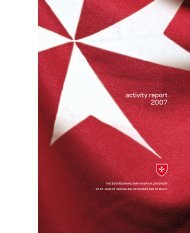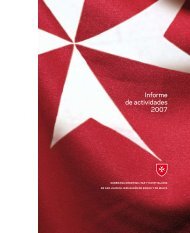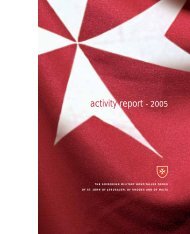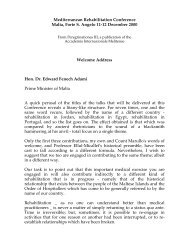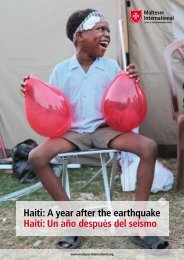Annual report 2005 Malteser International - Ordine di Malta
Annual report 2005 Malteser International - Ordine di Malta
Annual report 2005 Malteser International - Ordine di Malta
Create successful ePaper yourself
Turn your PDF publications into a flip-book with our unique Google optimized e-Paper software.
“We want to build aid bridges”<br />
Interview with Ingo Radtke, Secretary General of <strong>Malteser</strong> <strong>International</strong><br />
Disasters in recent times have shown<br />
how heavily dependent the <strong>di</strong>fferent<br />
regions of the world are upon one<br />
another. How is <strong>Malteser</strong> <strong>International</strong><br />
approaching this challenge?<br />
Buil<strong>di</strong>ng on the experiences of all<br />
relief agencies worldwide, <strong>Malteser</strong><br />
<strong>International</strong> is now the sole organ<br />
responsible for international humanitarian<br />
aid from the Order of <strong>Malta</strong>, combining<br />
aid from the 46 states in which the Order<br />
is present. Our relief is implemented<br />
worldwide – in the spirit of the Order of<br />
<strong>Malta</strong>, for the good of those in need and<br />
for the glory of God.<br />
What is your ideal vision of aid?<br />
We want to build ‘aid bridges’. In terms<br />
of humanitarian aid, this means: one pillar<br />
of the bridge is here and one is in the<br />
recipient country. We represent the pillar<br />
here, with our many thousands of helpers.<br />
With great commitment from volunteers<br />
and donations that are the expression<br />
of living solidarity with the victims.<br />
Thanks to extensive human and financial<br />
resources, on behalf of our sponsors we<br />
create con<strong>di</strong>tions for efficient aid where<br />
it is needed the most. The second pillar is<br />
in the country receiving aid. It is largely<br />
composed of local people.<br />
Are people in these areas capable of<br />
fulfilling requirements themselves<br />
then?<br />
Oh yes! We find this every time we<br />
provide aid: local people are absolutely<br />
partners at eye-level during these <strong>di</strong>sasters;<br />
they are not beggars in need of alms. This<br />
is why it is crucial that equal weight is<br />
<strong>di</strong>stributed between these two pillars for<br />
‘aid bridges’. They are intended not to<br />
create dependencies, but rather to bring<br />
people together.<br />
Is today’s focus still on major <strong>di</strong>sasters<br />
as it was right from the start?<br />
We were and remain active in many<br />
crises. We have been working in the<br />
Congo since 1994, focussing on the<br />
terrible consequences of the genocide in<br />
Rwanda. Other focal points include aid in<br />
the Balkans after the Dayton Agreement,<br />
in Honduras after hurricane Mitch, aid<br />
during and after the war in Kosovo, after<br />
floods in Mozambique and earthquakes in<br />
El Salvador, In<strong>di</strong>a and Iran and our most<br />
recent efforts in Afghanistan and Iraq as<br />
well as in areas hit by the tsunami.<br />
So a lot of your work is carried out in<br />
front of TV cameras and amongst a<br />
flurry of flashbulbs?<br />
No, not really. Our work doesn’t end<br />
with a few efforts after <strong>di</strong>sasters that<br />
have received heavy me<strong>di</strong>a coverage. We<br />
believe a crucial aspect of our work is<br />
the forgotten crises. The real dramas are<br />
played out beyond the reach of cameras.<br />
For example, who realises that more<br />
people have <strong>di</strong>ed as the result of hunger<br />
and war in the Congo in the last few years<br />
than during the tsunami that was labelled<br />
the ‘<strong>di</strong>saster of the millennium’? We are<br />
professionals who focus on the longterm.<br />
How would you sum up the provision<br />
of aid today?<br />
We should not limit ourselves to acute<br />
emergency aid. It is not enough to pull<br />
a drowning man from the water and<br />
then leave him to it with a few pieces<br />
of advice. Only once the ruined hut has<br />
been rebuilt and the means for existence<br />
destroyed by the flood have been reestablished<br />
will our aid have reached its<br />
primary objective, namely helping people<br />
to help themselves. We must be willing<br />
and able to be present 365 days a year and<br />
to accompany those affected by <strong>di</strong>saster<br />
until they are able to take control of their<br />
own lives again. Our ‘aid bridges’ are just<br />
what is required here.<br />
Interview by Sebastian Sigler<br />
8 I N T E R V I E W



